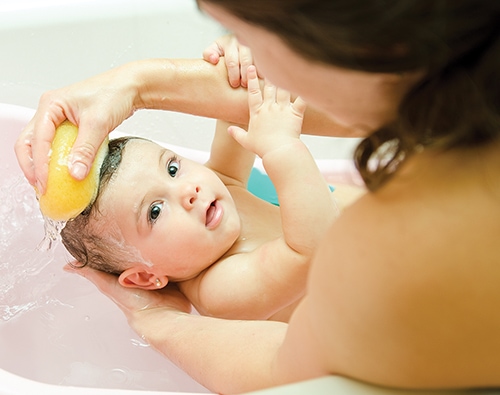Bathing your baby is not only essential to keeping your little one clean, baby bath time can be an extra special bonding time with your newborn. Let’s explore how to make bath time a safe and comfortable experience.
Baby Bath: Getting Ready
The first bath will be a sponge bath. Pick a warm room with a flat surface, like a bathroom or kitchen counter, a changing table, or a bed. Cover the surface with a thick towel. Keep baby from chilling with a room temperature of at least 75 degrees Fahrenheit.
Assemble all the baby bath items you will use:
• Baby bath sponge or clean wash cloth
• Clean blanket or bath towel
• Clean diaper
• Clean clothes
• Vaseline and gauze if you have a circumcised boy
• Warm water, not hot
Important: Never leave your baby alone in a bath — not even for a moment. If you must get to the phone, the stove, or whatever, take baby with you.
Baby’s Sponge Bath
Gentle sponge baths are perfect for the first few weeks until the umbilical cord falls off, the circumcision heals and the navel heals completely.
The basics of bathing a baby:
- First, undress baby — cradling the head with one hand. Leave the diaper on (wash that area last). Wrap baby in a towel, exposing only those areas that you are washing.
- Using a baby bath sponge or wash cloth, cleanse one area at a time. Start behind the ears, then move to the neck, elbows, knees, between fingers and toes. Pay attention to creases under the arms, behind the ears, around the neck.
- The hair comes toward the end of bath time so baby doesn’t get cold. While newborns don’t have much hair, you can sponge the few wisps that are there. To avoid getting eyes wet, tip the head back just a little. There’s no need for shampoo; just use water.
- Now it’s time to remove the diaper and sponge baby’s belly, bottom and genitals.
- Wash little girls from front to back. If there’s a little vaginal discharge, don’t worry — and don’t try to wipe it all away. If a little boy is uncircumcised, leave the foreskin alone. If circumcised, don’t wash the head of the penis until it’s healed.
- Gently pat baby dry. Rubbing the skin will irritate it.
- Dress in a clean diaper and clothes. Remember a onesie is best for sleep time.
Baby Bath: Tub Time
Once the umbilical cord falls off, and the circumcision and the navel are completely healed, it’s time to try a tub bath. Not all babies like the transition, so if your baby gets fussy, go back to sponge baths for a week or so, then try again. Bathing a baby is a process — an adjustment for both baby and parent.
Use a safe, sturdy tub. Baby bath tubs can be “bucket style” for sitting upright, slanted for support, inflatable, folding and spa-style. Make sure all the parts of the tub are working properly and are attached securely. Foldable tubs can be more convenient for storage but often are not as sturdy as non-foldable ones. Many of the injuries that involved a baby’s limb or other body part becoming trapped happened in a tub that folded. Inflatable tubs may be more likely to collapse.
Be aware of bumps, edges and slings. In many of the incidents where bumps on the tub caused injuries, a sling made of fabric or mesh was involved. Consider avoiding tubs with slings or pay close attention to any bumps or edges that pose a risk. When buying a hard plastic tub, look for a smooth shape and edges. Avoid tubs with places where your baby could be pinched.
Check for rust and mold. Drain the tub completely after each use to avoid rust and mold. You also can use a tub with a plug or drain at the base to drain water after bath time. Some tubs even have a mildew-resistant foam lining.
Never leave a child alone in a bathtub. Children can drown in 1 or 2 inches of water. Don’t turn your back even for a moment or leave babies in the care of another child.
Check water temperature. Lower the temperature of your water heater to no more than 120 degrees Fahrenheit to avoid burns.
Bathing a Baby: The First Tub Bath
Make the first tub baths quick ones. If baby is too fussy with this transition, go back to a sponge bath. Fill the tub with only 2 or 3 inches of warm — not hot — water. Use one hand to support baby’s head, then slowly lower them.
- Using a washcloth or baby bath sponge, wash the face and hair. When rinsing, protect eyes with your hand across the forehead. Gently wash the rest of baby with water and a small amount of soap.
- Use water or a cleanser designed for babies. As hair grows, try gentle baby shampoo.
- To keep baby warm during the bath, cup your hand to let handfuls of water wash over baby’s chest.
- Gently pat baby dry. Apply baby lotion all over to seal in moisture.
- Now it’s time for a fresh diaper. Apply diaper ointment as needed to protect against irritation.
- When bath time is over, wrap baby in a towel right away, covering baby’s head for warmth.
- Dress in a clean clothes. Remember a onesie and other Safe Sleep steps if it’s sleep time.
Resources
American Academy of Pediatrics






